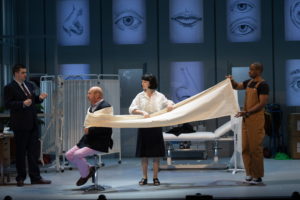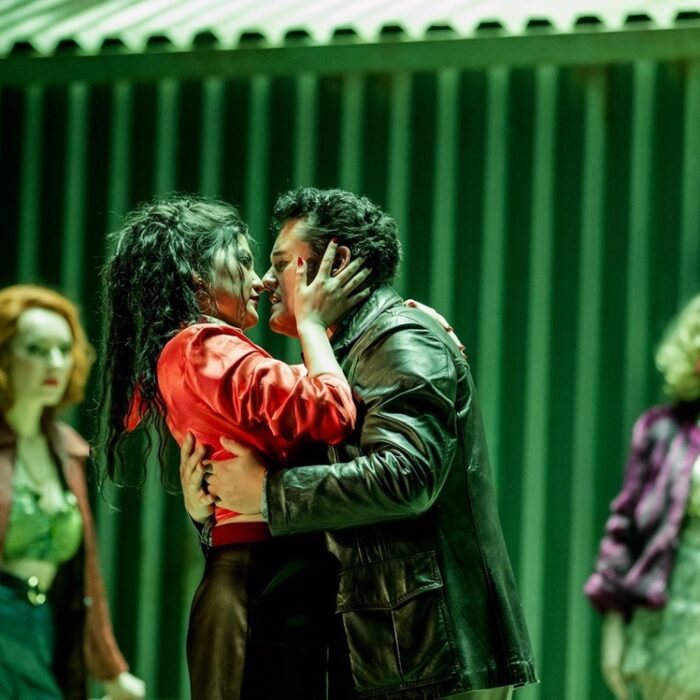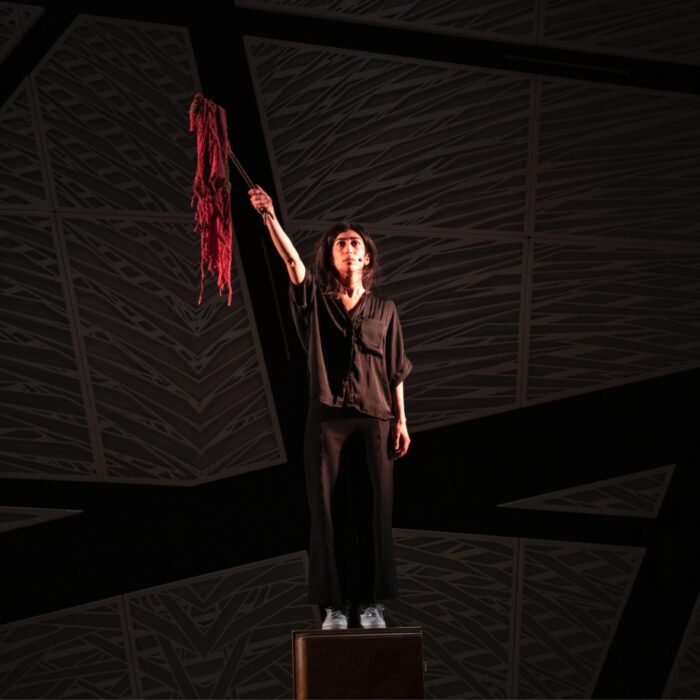
Irish National Opera 2022-23 Review: Don Pasquale
Phelan’s Successful Direction Has The Audience Smiling, Laughing & Cheering Out Loud
By Alan Neilson(Photo: Pat Redmond)
The reaction of the audience at Dundalk’s Táin Theatre to Irish National Opera’s performance of Donizetti’s “Don Pasquale” said it all! Every scene, every joke, every overplayed reaction, every facial exaggeration was met with unaffected laughter. Rarely does one find an audience so totally engaged with a piece. At the final curtain, the performance was met with loud cheers and sustained applause from the audience members and, as they made their way towards the exit, their smiling faces and excited conversation lit up the foyer.
Not a small amount of the credit for the success must go down to the director Orpha Phelan, whose masterful handling of the work ensured that the comedic potential of Angelo Anelli’s 1810 libretto, reworked by Giovanni Ruffini and Donizetti for its 1843 Paris premiere, was fully developed. By chance of circumstance, this is the second production by Phelan to have been reviewed by OperaWire in the past few weeks. She also directed Wexford Festival Opera’s successful presentation of “Lalla Rookh,” which again showed off her talent for comedy to good effect.
Malatesta’s Plastic Surgery Opens For Business
For both productions, Phelan’s staging displayed a clear vision, overall coherence, attention to detail and a tendency towards bold decision-making. For this production of “Don Pasquale,” she landed on the idea of having Dr. Malatesta adopt the role of a plastic surgeon and of using his surgery as a backdrop for the drama. Not only did this allow for a raft of gags, such as having boxes of viagra and silicon implants piled up in a corner, but it also created an environment in which comical and absurd narcissistic and egotistic tendencies could be given full reign. Don Pasquale’s appointment for a cosmetic makeover, therefore, proved an ideal way of getting the ball rolling.
The staging, designed by Nicky Shaw, was simple, imaginative and effective. Act one took place in Dr. Malatesta’s waiting room, which featured large pictures on the back wall of noses, lips, eyes and ears that his customers might prefer to the miserable efforts that adorned their own faces. Above the pictures was the text, “Dr. Malatesta, Plastic Surgeon To The Stars.” Act three moved to Don Pasquale’s house, which was furnished with plenty of large plants, a drinks trolley, comfy seats and a tiger skin rug.
The designs allowed for the small chorus to enter and leave naturally without disrupting the dramatic flow, and there were plenty of places for the characters to hide themselves away, which added to the potential for slapstick.
The costumes, also designed by Shaw, were as one would expect to find in a doctor’s surgery. They were generally low-key, although her treatment of Norina disguised as Sofronia was highly amusing. Initially, she appeared to be dull, uninteresting drab dressed in a black wig with white blouse and black skirt and cardigan with flat back sandals, but following her faux marriage to Pasquale, she was transformed into a vamp, dressed in a tight fitting leopard skin dress.
It was the perfect backdrop for Phelan’s interpretation, whose focus was on exploiting the situations to ramp up the comedy with plenty of movement and slapstick. Characterization was of secondary importance. She stuck closely to tried-and-tested stereotypes, so that they never developed beyond two dimensions. And it all worked brilliantly. The audience lapped it up, laughing out loud throughout the show.
The Irish National Opera Orchestra was reduced to just 12 members, but this did not prevent the conductor, Teresa Riveiro Böhm, from eliciting a strong performance that possessed the necessary depth and textural variety to support the drama and maintain its musical integrity. In fact, such was the energy and drive she was able to create that the music fizzed along and added to the lively staging, yet without ever undermining its elevated quality.
Danby Leads A strong Cast
The four principal roles were all well-cast. In the title role of Don Pasquale was bass Graeme Danby, who displayed a natural comedic bent in which he hammed up every situation for all it was worth. Possessing an impressive array of comical facial expressions along with the ability to amusingly exaggerate his movements, he successfully created a character with whom one could not help but sympathize, despite the fact that his motives were fairly unsavory. At one point, while awaiting surgery, he found himself dancing around dressed only in his underwear, much to the amusement of the audience. Danby’s acting was matched by his equally strong singing, which was lively and energetic throughout. His voice possesses an attractive, warm timbre and a versatility that allowed him to seamlessly blend his singing with the comedy. It was a fine portrait of the old rogue, one that was touchingly molded.
Kelli-Ann Masterson produced a convincing performance as three different characters: firstly as Malatesta’s nurse and the object of Don Pasquale’s desires, Norina; and secondly and thirdly as Norina, disguised as Sofronia, but with two very different personalities, one as the innocent, dull girl whom Pasquale wants to marry, and then as the vitalized and hyper-charged version after she is married. All three versions were confidently played, and they really did appear to have distinct characters. In fact, Masterson’s acting suggested she had a natural empathy for her character. Moreover, she also exhibited a flair for comedy, which allowed her to spark off the other characters. Her piercing, bright, versatile soprano was nicely suited to the role; her voice tripped easily along the line, moving easily up and down the stave, which she embellished with pleasing detail, trills and an impressive coloratura. It was also done with an eye toward affect, so that her singing was closely allied to her characterization.
By comparison to Don Pasquale and Norina, baritone Ben McAteer’s Malatesta was a more reflective character who moved in and out of the picture to manipulate events, although, of course, not without engendering his fair share of laughs along the way. McAteer produced a polished performance in which his splendidly crafted recitatives, replete with detailed dynamics and colorful contrasts, impressed. His singing in the duets was equally successful and allowed him to show off the beautiful lyricism of his voice to good effect.
Patrick Kabongo, cast as Ernesto, has an engaging, secure, high-lying tenor with a homogeneous sound, which he used with a considerable degree of flexibility. It is also a resonant voice, but the characteristic that captures the attention is its natural beauty, which was nicely displayed in the duet with Norina, “Tornami a dir che m’ami,” in which the two voices combined to create a pleasing harmony. On the negative side, however, he always appears to be a little too comfortable. One would like to see more passion, more energy in his singing. A similar criticism holds for his acting, which again appeared to be a little too relaxed: he never seemed truly concerned about the fact that he was about to lose Norina.
Mezzo-soprano Leanne Fitzgerald was cast in the small role of the Notary and made a good impression.
The Irish National Opera Chorus consisted of just five singers. Yet what it lacked in numbers, it certainly made up for with its enthusiasm and wholehearted engagement. The quality and strength of the singers were excellent, and together they created an impressive stage presence.
Overall, this was a wonderful production that captured the fun at the heart of the work. Even with a mindset that was determined not to enjoy this production, it would have been impossible to hold back the laughter. It was great fun. Moreover, it has been superbly constructed so that even with a small orchestra and chorus, perfect for touring while keeping costs down, it did not compromise the audience’s enjoyment at all.



